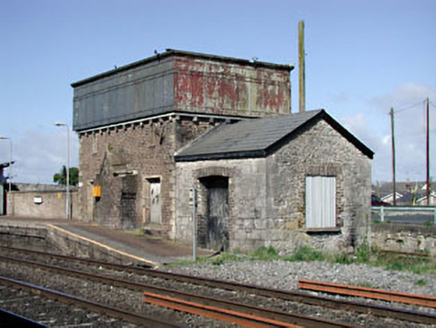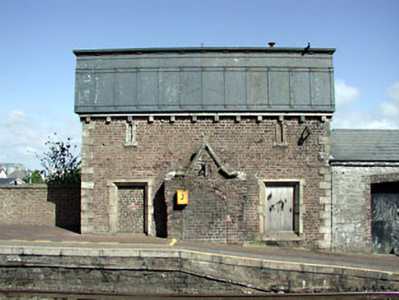Survey Data
Reg No
11811030
Rating
Regional
Categories of Special Interest
Architectural, Artistic, Historical, Social, Technical
Previous Name
Sallins Railway Station
Original Use
Water tower
Date
1850 - 1900
Coordinates
289243, 222671
Date Recorded
26/04/2002
Date Updated
--/--/--
Description
Freestanding three-bay two-storey red brick former water tower, c.1875, with single-bay single-storey gabled advanced porch to centre and cast-iron water tank over. Now disused. Cast-iron section tank to roof on corbelled eaves with ‘pilaster’ strips having rosette motifs and consoles cornice. Red brick Flemish bond walls. Cut-granite dressings including quoins to corners. Cut-granite coping to parapet wall to advanced porch. Cut-granite corbelled eaves course. Square-headed window openings (slit-style to first floor). Cut-granite chamfered sills and block-and-start surrounds. Now blocked-up (red brick). Outline of pointed-arch door opening. Now blocked-up (red brick). Set back from road in grounds shared with Sallins (and Naas) Railway Station flanking platform to north-west. Attached single-bay single-storey rubble stone outbuilding, c.1880, to north-east. Now disused. Gable-ended roof with slate. Clay ridge tiles. Timber eaves. Coursed rubble limestone walls. Cut-stone quoins to corners. Square-headed door opening. Cut-stone sill. Red brick dressings. Boarded-up. Shallow segmental-headed door opening. Red brick surround. Boarded-up.
Appraisal
This water tower is an attractive component of the Sallins (and Naas) Railway Station complex, which has become somewhat obscured by the lengthening of the platform along the front (south-east) elevation. Although now disused the water tower retains most of its form and character and the primary elevation is of architectural interest, having been conceived as a Tudor Gothic composition that echoes on a diminished scale the railway station building to south-west (11811028/KD-19-11-28). Of considerable technical interest, the water tower attests to the nineteenth-century method of storing and supplying adequate water and the tank, which is a good example of early cast-iron work, was also conceived as an aesthetic piece. Together with the remaining attendant structures, the water tower is of considerable historical and social significance, having been built as part of the railway network development in Ireland that improved the efficiency of public transport and linked remote areas of the country with larger urban settlements and ports.



